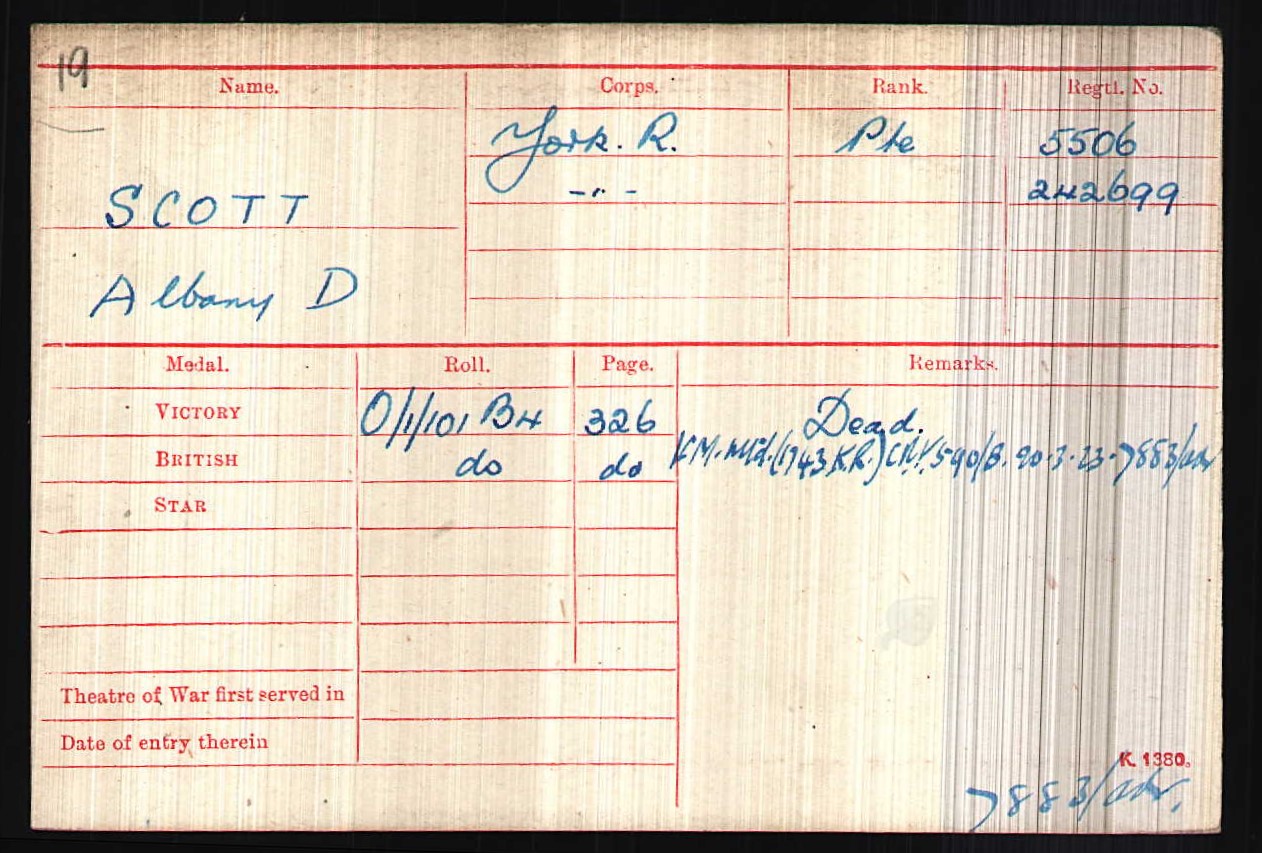
Albany was born on the 18th April 1882 to Robert Scott and Elizabeth Bridgwood in Bradford, Yorkshire and was 32 years old when war broke out. He was married to his wife Mary Ascough, had two young children, son Kenneth and daughter Olive. He had a job as an estate gardener and lived in a tied cottage in Snainton, Yorkshire. He enlisted in Scarborough and it is unclear why he joined the war effort with the Territorial Force but it was said he was not a drinker and had numerous Temperance Medals to prove so!
He began his military career as a member of the Territorial Force with the service number 5506. His medal roll adds that he was in both the 6th and then the 5th Battalions of the Yorkshire Regiment, before he was transferred into the 2nd Battalion Yorkshire Regiment in 1916, with a new service number of 242699, possibly first seeing action at the southern end of the British Somme offensive line and at the battle of Transloy Ridges, in October 1916.
During this time period he came home wounded, was allowed to recuperate, and once he was fit, he returned back to the front line in early 1917. During the German Spring Offensive of 1918, the Germans grouped in thick fog and overran the trenches where Albany was fighting and took him, along with many others, prisoner on March 22nd. Unfortunately a shell exploded nearby and captors and captured alike were killed. He was 4 weeks short of his 37th birthday, leaving behind his family and quite a legacy…
Explore more memories from the ribbon
-
Albany D Scott
Albany was born on the 18th April 1882 to Robert Scott and Elizabeth Bridgwood in Bradford, Yorkshire and was 32 years old when war broke out. He was married to his wife Mary Ascough, had two young children, son Kenneth and daughter Olive. He had a job as an estate gardener and lived in a tied cottage in Snainton, Yorkshire. He enlisted in Scarborough and it is unclear why he joined the war effort with the Territorial Force but it was said he was not a drinker and had numerous Temperance Medals to prove so! He began his military career as a member of the Territorial Force with the service number 5506. His medal roll adds that he was in both the 6th and then the 5th Battalions of the Yorkshire Regiment, before he was transferred into the 2nd Battalion Yorkshire Regiment in 1916, with a new service number of 242699, possibly first seeing action at the southern end of the British Somme offensive line and at the battle of Transloy Ridges, in October 1916. During this time period he came home wounded, was allowed to recuperate, and once he was fit, he returned back to the front line in early 1917. During the German Spring Offensive of 1918, the Germans grouped in thick fog and overran the trenches where Albany was fighting and took him, along with many others, prisoner on March 22nd. Unfortunately a shell exploded nearby and captors and captured alike were killed. He was 4 weeks…
-
Duncan Harvie
Vicki Walker of Little Crakehall called into the museum to show us a photograph of Duncan Harvie, her grandfather. The photo is a postcard addressed to ‘Mary and Sam’, sent on 3 April 1916 and shows a group of Signallers on board HMS Laconia. Duncan Harvie (5th South African Regiment) is sat at the front of the group with crossed legs. The ship’s log shows the Laconia (an armed merchant cruiser) to be anchored at Zanzibar on that date, on it’s way to British East Africa (now Kenya). The ship was used in the early part of the war to patrol the South Atlantic and the Indian Ocean, but in April 1915 her role changed and she was used as a headquarters ship to aid in the fight in German East Africa. Following her return to to Cunard, the Laconia was sunk by U-50 160 miles northwest of Fastnet while returning form the United States on 25th February 1917. Twelve people were killed following a double torpedo strike.
-
John MacKenzie
Elspeth De Montes told us about her grandad John MacKenzie, a carpenter, who was called up in August 1914. “John had been working as a carpenter for James Bryce in Clephanton since April 1910 when he was called up on 4th August 1914. He enlisted with the Highland Mounted Brigade at Nairn eventually being posted to to Egypt in 1916. He worked chiefly on the wagons, greasing and making slight repairs but he also saw action throughout his time in Egypt. During an air raid at Ramleh on 27th November 1917 5 men were killed along with approximately 100 horses.” John survived his time in Egypt, returning home on 4th April 1919. He kept some of his equipment in the Princess Mary Tin he received during his service. Elspeth still has his Princess Mary tin. He passed away in 1980.
